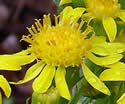Senecio integerrimus (Lambstongue Ragwort)
| Also known as: | Entire Ragwort, Western Groundsel |
|---|---|
| Genus: | Senecio |
| Family: | Asteraceae (Aster) |
| Life cycle: | biennial, perennial |
| Origin: | native |
| Habitat: | part shade, sun; open prairie, open woods, rock outcrops |
| Bloom season: | April - June |
| Plant height: | 9 to 26 inches |
| Wetland Indicator Status: | GP: FAC MW: FAC NCNE: FAC |
| MN county distribution (click map to enlarge): |  |
| National distribution (click map to enlarge): |  |
Pick an image for a larger view. See the glossary for icon descriptions.
Detailed Information
Flower: 

![[photo of flowers]](/udata/r9ndp23q/pd/senecio-integerrimus-12-49-t.jpg) Dense rounded or flat-topped, branched cluster of 6 to 20 short-stalked, bright yellow flowers at the tip of the stem and arising from upper leaf axils. Flowers are ½ to ¾ inch across with a large center disk surrounded by (usually) 8 to 13 linear-oblong ray flowers (petals). The barrel-shaped base cupping the flower head is formed from 13 to 21 linear floral bracts (phyllaries), green but sometimes with darker tips. Flower stalks and phyllaries are variously covered in cobwebby hairs and may become smooth with age.
Dense rounded or flat-topped, branched cluster of 6 to 20 short-stalked, bright yellow flowers at the tip of the stem and arising from upper leaf axils. Flowers are ½ to ¾ inch across with a large center disk surrounded by (usually) 8 to 13 linear-oblong ray flowers (petals). The barrel-shaped base cupping the flower head is formed from 13 to 21 linear floral bracts (phyllaries), green but sometimes with darker tips. Flower stalks and phyllaries are variously covered in cobwebby hairs and may become smooth with age.
Leaves and stems: 


![[photo of leaves]](/udata/r9ndp23q/pd/senecio-integerrimus-12-7-t.jpg) Leaves are mostly basal, thick and fleshy, lance-oblong or elliptical, 3 to 9½ inches long, 1 to 1½ inches wide, edges typically smooth or with a few shallow teeth, surfaces covered in dense cobwebby hairs but becoming mostly smooth by flowering time, except in the axils. Basal leaves are stalked.
Leaves are mostly basal, thick and fleshy, lance-oblong or elliptical, 3 to 9½ inches long, 1 to 1½ inches wide, edges typically smooth or with a few shallow teeth, surfaces covered in dense cobwebby hairs but becoming mostly smooth by flowering time, except in the axils. Basal leaves are stalked.
![[photo of stem and upper leaf hairs]](/udata/r9ndp23q/pd/senecio-integerrimus-12-13-t.jpg) Upper leaves are few, becoming smaller as they ascend the stem, more lance shaped, toothless, unlobed, and stalkless. Stems are stout, single or multiple from the base but simple (unbranched) above, variously hairy with cobwebby or wiry hairs when young, becoming mostly smooth except in the flower clusters.
Upper leaves are few, becoming smaller as they ascend the stem, more lance shaped, toothless, unlobed, and stalkless. Stems are stout, single or multiple from the base but simple (unbranched) above, variously hairy with cobwebby or wiry hairs when young, becoming mostly smooth except in the flower clusters.
Fruit: 
Fruit is a dry seed (achene) with a tuft of white hair (pappus) to carry it off in the wind.
Notes:
The genus Senecio is a large group of mostly native western species (and a few introductions). S. integerimus itself has five varieties with var. integerrimus the eastern-most, and the only native species of this genus found in Minnesota. Until recently, Senecio also included the genus Packera, which itself is another large group with six species native to Minnesota, as well as Marsh Ragwort (Tephroseris palustris). While these are all fairly similar with terminal clusters of yellow daisy-type flowers, large basal rosettes and few stem leaves, Lambstongue Ragwort, also known as Entire Ragwort, can be distinguished from these other native ragworts by its soft, fleshy leaves that are not lobed and have few if any teeth, and fleshy roots, where the other native ragwort species have deeply lobed stem leaves and more fibrous roots.
Native Plant Nurseries, Restoration and Landscaping Services ↓
More photos
 Lambstongue Ragwort plant
Lambstongue Ragwort plant Lambstongue Ragwort plants
Lambstongue Ragwort plants Lambstongue Ragwort plants
Lambstongue Ragwort plants Lambstongue Ragwort habitat
Lambstongue Ragwort habitat more flowers
more flowers a pollinator
a pollinator
Photos courtesy Peter M. Dziuk taken in Renville county.
Comments
Have you seen this plant in Minnesota, or have any other comments about it?






